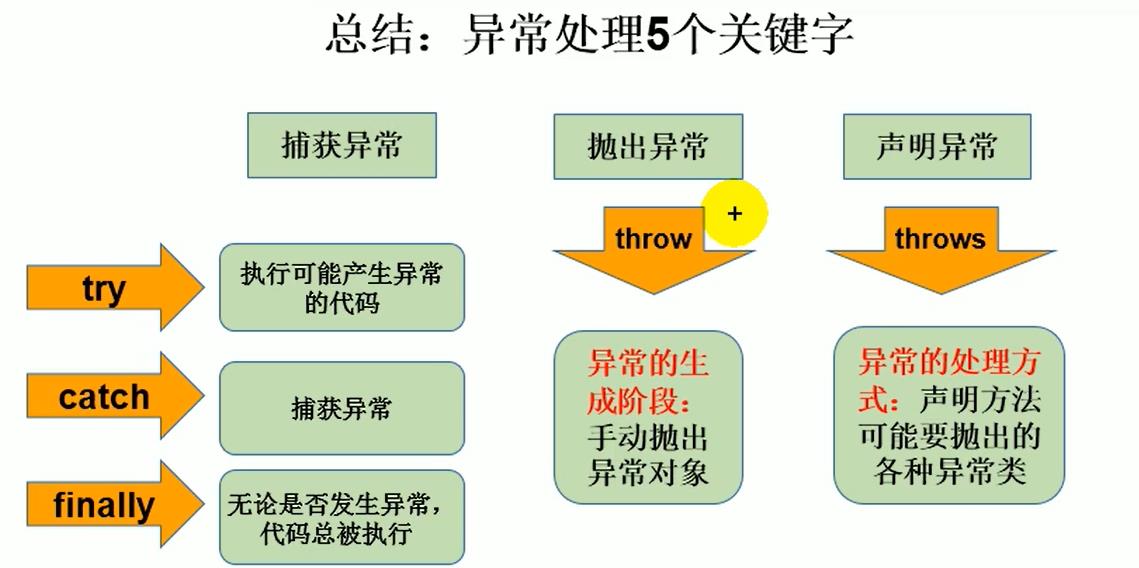Java 中的异常处理详解
Posted 路 宇
tags:
篇首语:本文由小常识网(cha138.com)小编为大家整理,主要介绍了Java 中的异常处理详解相关的知识,希望对你有一定的参考价值。
前言: Java程序在执行过程中发生的异常情况分为两类:
一、 Error:Java虚拟机无法解决的严重问题,如:JVM系统内部错误,资源耗尽等严重情况比如StackOverflowError和OOM。一般不编写针对性的代码进行处理。
public class ExceptionTest {
public static void main(String[] args) {
//1.栈溢出 java.lang.StackOverflowError
// main(args);
//2.堆溢出 java.lang.OutOfMemoryError 简称OOM
Integer[] integers = new Integer[1024*1024*1024];
}
}
二、Exception :其它因编程错误或偶然的外在因素导致的一般性的问题,可以使用针对性的代码进行处理。
例如:
- 空指针访问
- 试图读取不存在的文件
- 网络连接中断
- 数组角标越界
三、异常体系结构:

3.1.编译时异常:

我标注出来的就是编译时异常。
3.2常见的运行时异常例子: 具体注释都已经在代码中给出
@Test
public void test1(){
//NullPointerException 空指针异常
int[] arr = null;
System.out.println(arr[3]);
}
//IndexOutOfBoundsException 角标越界或索引越界
@Test
public void test2(){
//ArrayIndexOutOfBoundsException 数组角标越界异常
// int[] arr = new int[10];
// System.out.println(arr[10]);
//StringIndexOutOfBoundsException 字符串越界异常
String str = "abc";
System.out.println(str.charAt(3));
}
@Test
public void test3(){
//ClassCastException 类型转换异常
Object obj = new Date();
String str = (String) obj;
}
@Test
public void test4(){
//NumberFormatException 数字格式异常
String str = "123";
str="abc";
int i = Integer.parseInt(str);
}
@Test
public void test5(){
//InputMismatchException 输入不匹配异常
Scanner scanner = new Scanner(System.in);
int i = scanner.nextInt();
System.out.println(i);
}
@Test
public void test6(){
//ArithmeticException 算术异常
int a = 10;
int b=2;
b=0;
System.out.println(a/b);
}
四、异常处理机制:
抓抛模型:
过程一:“抛” :程序正在执行的过程中,一旦出现异常,就会在异常代码处生成一个对应异常类的对象,并将此对象抛出,一旦抛出对象后,其后的代码就不再执行。
过程二:“抓”:可以理解为异常的处理方式
- try-catch-finally
- throws
4.1try-catch-finally的使用:
try{
//可能出现异常的代码
}catch(异常类型1 变量名1){
//处理异常的方式1
}catch(异常类型2 变量名2){
//处理异常的方式2
}catch(异常类型3 变量名3){
//处理异常的方式3
}
.....
finally{
//一定会执行的代码
}
具体例子代码如下:
@Test
public void test1(){
String str="123";
str = "abc";
try {
int i = Integer.parseInt(str);
System.out.println("hello----1");
}catch (NumberFormatException e){
e.printStackTrace();
// System.out.println("出现了转换异常");
//String getMessage():
// System.out.println(e.getMessage());
}catch (NullPointerException e){
e.printStackTrace();
}catch (Exception e){
e.printStackTrace();
}
}
注意:
- finally是可选的
- 使用try将可能出现的异常代码包装起来,在执行过程中,一旦出现异常,就会生成一个对应异常类的对象,根据此对象的类型,去catch中进行匹配。
- 一旦try中的异常对象匹配到某个catch时,就进入catch中进行异常的处理。一旦处理完成,就跳出当前的try-catch结构(在没有写finally的情况)。继续执行其后的代码。
- catch中的异常类型如果没有子父类关系,则谁声明在上,谁声明在下无所谓
catch中的异常类型如果满足子父类的关系,则要求子类一定声明在父类的上面。否则,报错。 - 常用的异常对象处理的方式:1.String getMessage() 2.printStackTrace()
- 在try中声明的变量,在出了try结构以后,就不能再被调用。
体会1:使用try-catch-finally处理编译时异常,使得程序在编译时就不再报错,但是运行时仍可能报错。相当于我们使用try-catch-finally将一个编译时可能出现的异常,延迟到运行时出现。
体会2:开发中,由于运行时异常比较常见,所以我们通常就不针对运行时异常编写try-catch-finally了,针对于编译时异常,我们一定要考虑异常的处理。
4.2.try-catch-finally中finally的使用:
public int method(){
try{
int[] arr = new int[10];
System.out.println(arr[10]);
return 1;
}catch (ArrayIndexOutOfBoundsException e){
e.printStackTrace();
return 2;
}finally {
System.out.println("一定会执行的代码!");
}
}
@Test
public void test2(){
int num = method();
System.out.println(num);
}
输出结果:
java.lang.ArrayIndexOutOfBoundsException: 10
at www.demo11.ExceptionTest2.method(ExceptionTest2.java:29)
at www.demo11.ExceptionTest2.test2(ExceptionTest2.java:40)
at sun.reflect.NativeMethodAccessorImpl.invoke0(Native Method)
at sun.reflect.NativeMethodAccessorImpl.invoke(NativeMethodAccessorImpl.java:62)
at sun.reflect.DelegatingMethodAccessorImpl.invoke(DelegatingMethodAccessorImpl.java:43)
at java.lang.reflect.Method.invoke(Method.java:498)
at org.junit.runners.model.FrameworkMethod$1.runReflectiveCall(FrameworkMethod.java:50)
at org.junit.internal.runners.model.ReflectiveCallable.run(ReflectiveCallable.java:12)
at org.junit.runners.model.FrameworkMethod.invokeExplosively(FrameworkMethod.java:47)
at org.junit.internal.runners.statements.InvokeMethod.evaluate(InvokeMethod.java:17)
at org.junit.runners.ParentRunner.runLeaf(ParentRunner.java:325)
at org.junit.runners.BlockJUnit4ClassRunner.runChild(BlockJUnit4ClassRunner.java:78)
at org.junit.runners.BlockJUnit4ClassRunner.runChild(BlockJUnit4ClassRunner.java:57)
at org.junit.runners.ParentRunner$3.run(ParentRunner.java:290)
at org.junit.runners.ParentRunner$1.schedule(ParentRunner.java:71)
at org.junit.runners.ParentRunner.runChildren(ParentRunner.java:288)
at org.junit.runners.ParentRunner.access$000(ParentRunner.java:58)
at org.junit.runners.ParentRunner$2.evaluate(ParentRunner.java:268)
at org.junit.runners.ParentRunner.run(ParentRunner.java:363)
at org.junit.runner.JUnitCore.run(JUnitCore.java:137)
at com.intellij.junit4.JUnit4IdeaTestRunner.startRunnerWithArgs(JUnit4IdeaTestRunner.java:69)
at com.intellij.rt.junit.IdeaTestRunner$Repeater.startRunnerWithArgs(IdeaTestRunner.java:33)
at com.intellij.rt.junit.JUnitStarter.prepareStreamsAndStart(JUnitStarter.java:220)
一定会执行的代码!
2
分析:
- finally是可选的
- finally中声明的是一定会被执行的代码,即使catch中又出现了异常,try中有return语句,catch中有return等情况
- 像数据库连接,输入输出流,网络编程Socket等资源,JVM是不能自动的回收的,我们需要自己手动的进行资源的释放,此时的资源释放,就需要声明在finally中。
例如IO流中对输入流最后的资源关闭如下:
@Test
public void test3() {
FileInputStream fis = null;
try {
File file = new File("hello.txt");
fis = new FileInputStream(file);
int len;
while ((len = fis.read()) != -1) {
System.out.print((char) len);
}
} catch (FileNotFoundException e) {
e.printStackTrace();
} catch (IOException e) {
e.printStackTrace();
} finally {
try {
if (fis != null) {
fis.close();
}
} catch (IOException e) {
e.printStackTrace();
}
}
}
4.2.异常处理的方式二:throws+异常处理
- throws+异常处理 写在方法的声明处。指明此方法执行时,可能会抛出的异常类型。一旦方法体执行时,出现异常,仍会在代码异常处生成一个异常类的对象,此对象满足throws后异常类型时,就会被抛出。异常代码后续的代码就不再执行。
体会:try-catch-finally:真正的将异常给处理掉了。
throws的方式只是将异常抛给了方法的调用者,并没有真正的将异常处理掉。
注意:
开发中如何选择使用try-catch-finally还是使用throws+异常类型?
- 如果父类中被重写的方法没有throws方式处理异常,则子类重写的方法也不能使用throws,意味着如果子类重写的方法中有异常,必须使用try-catch-finally方式处理。
- 执行的方法A中,先后又调用了另外的几个方法,这几个方法是递进关系执行的。我们建议这几个方法使用throws的方法处理,而执行的方法A可以考虑使用try-catch-finally处理。
五、手动抛出异常:
手动的生成一个异常对象,并抛出(throw)
@Test
public void test4() {
try {
Student s = new Student();
s.subClass(-1001);
System.out.println(s);
} catch (Exception e) {
System.out.println(e.getMessage());
}
}
class Student {
private int id;
private void subClass(int id) throws Exception {
if (id > 0) {
this.id = id;
} else {
throw new Exception("您输入的数据非法哦!");
//手动抛出异常对象
// throw new RuntimeException("您输入的数据非法!");
}
}
@Override
public String toString() {
return "Student{" +
"id=" + id +
'}';
}
}
六:自定义异常类:
- 继承于现有的异常结构:RunTimeException,Exception
- 提供全局变量 serialVersionUID
- 提供重载的构造器
public class MyException extends RuntimeException {
static final long serialVersionUID = -7034125766939L;
public MyException() {
}
public MyException(String message) {
super(message);
}
}
总结:

以上就是异常处理的全部内容,有不当之处,还望在评论区指正,一起学习,共同进步!
以上是关于Java 中的异常处理详解的主要内容,如果未能解决你的问题,请参考以下文章